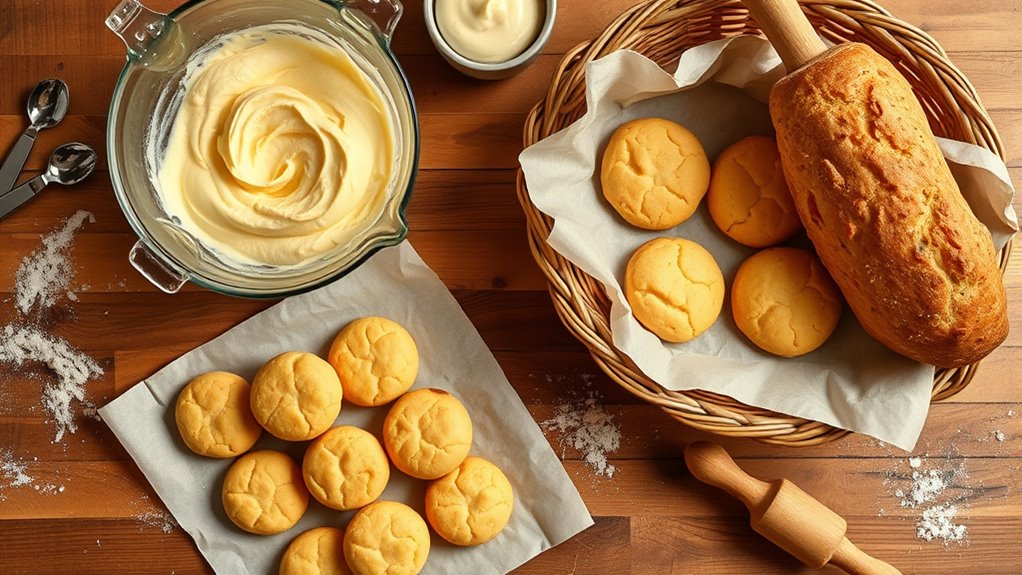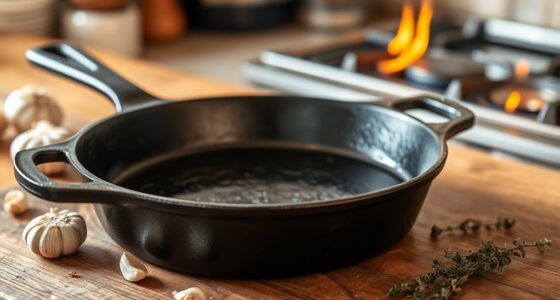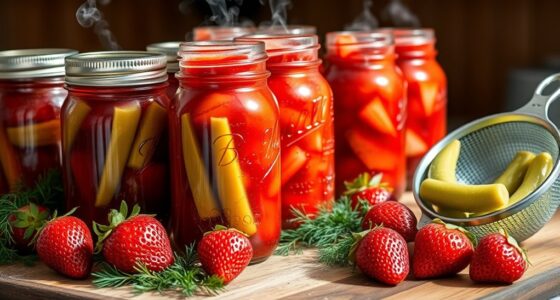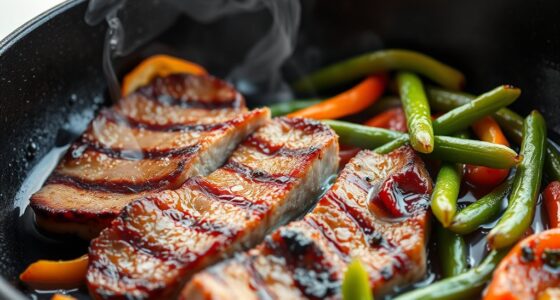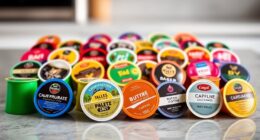To succeed in baking cakes, cookies, and bread, focus on precise measurements, ingredient quality, and proper oven temperatures. Use an oven thermometer to guarantee accuracy and avoid opening the door mid-bake. Adjust recipes carefully if you swap ingredients like eggs or fats to maintain texture and moisture. Keep an eye on your baked goods for signs of doneness, and don’t hesitate to tweak temperatures or times based on results. Want to master your baking skills? Keep exploring for more expert tips.
Key Takeaways
- Use precise oven temperatures and preheat thoroughly for even rising and proper crumb development.
- Consider ingredient substitutions carefully, adjusting moisture and leavening to maintain texture and flavor.
- Calibrate your oven regularly to ensure accurate temperature control and consistent baking results.
- Observe baked goods during baking to identify signs of doneness and prevent over- or under-baking.
- Utilize proper tools like oven thermometers and avoid opening the oven door frequently to maintain consistent heat.
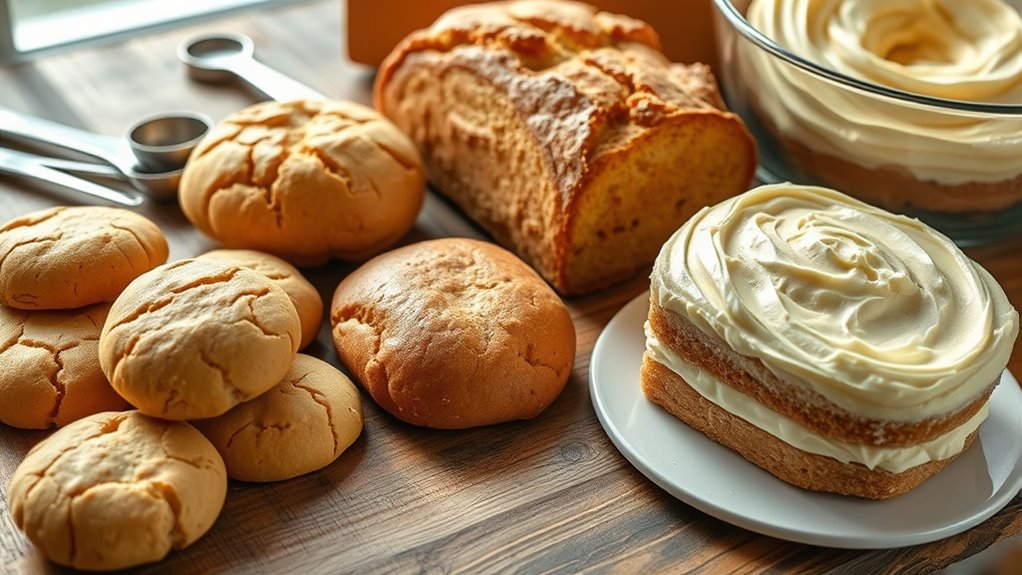
Have you ever wondered what it takes to create perfect baked goods? One of the most significant aspects is understanding how ingredient substitutions can influence your results. When you don’t have a specific ingredient on hand, knowing which substitutions work best can save your baking project from failure. For example, if you’re out of eggs, you might use applesauce or mashed bananas as a substitute, but keep in mind these can alter the texture and flavor. Similarly, swapping baking soda for baking powder isn’t always straightforward; each has different leavening power and acidity requirements. It’s vital to consider how these substitutions will affect the overall outcome and adjust other ingredients if needed. Also, be aware that some substitutions can change the moisture content or density of your baked goods, so experimenting in small batches first can help you refine your approach.
Another fundamental factor is oven temperature, which can make or break your baked goods. Many bakers underestimate how vital precise oven settings are. For cakes, maintaining a consistent temperature ensures they rise evenly and develop a tender crumb. Cookies are sensitive to temperature fluctuations, which can cause uneven baking or spreading. Breads require specific oven temperatures for proper crust formation and rise. Always preheat your oven thoroughly before baking, and use an oven thermometer to verify the actual temperature inside. Oven calibration can sometimes be off, so relying solely on the dial might lead to under- or over-baking. Adjust your oven temperature according to your recipe’s instructions, but also observe how your oven behaves over time. If you notice your baked goods are consistently browning too fast or not enough, tweak the temperature accordingly. Remember, opening the oven door during baking can cause temperature drops, affecting how your treats turn out, so avoid peeking excessively.
Being aware of specialized equipment like oven thermometers and proper baking tools can also greatly improve your results. Understanding the relationship between ingredient substitutions and oven temperature helps you become more adaptable and confident in the kitchen. When you need to make a swap, consider how it might impact the baking process and adjust your oven settings if necessary. For instance, if you use a wetter substitute like yogurt instead of oil, your batter might need a slightly lower oven temperature to prevent overbaking or burning. Conversely, if you’re using a drier ingredient, you might want to increase the oven temperature slightly to ensure proper cooking. The key is to stay observant and flexible, making small adjustments based on how your baked goods look and feel during baking. Mastering these basics will help you create consistently delicious cakes, cookies, and breads, no matter what ingredients or oven quirks you encounter.
Frequently Asked Questions
How Do I Troubleshoot Flat or Dense Cakes?
To troubleshoot flat or dense cakes, first check your cake structure by ensuring you’re using the correct amount of leavening agents like baking soda or powder. Also, verify your baking temperature; if it’s too low, your cake won’t rise properly, resulting in a dense texture. Avoid overmixing the batter, which can deflate the air bubbles needed for a light, fluffy cake. Adjust these factors to improve your cake’s rise and texture.
What Are the Best Substitutes for Eggs in Baking?
Oh, the great egg dilemma—do you stick with traditional or venture into the wild world of vegan alternatives? Luckily, you can swap eggs with natural binding agents like mashed bananas, applesauce, or flaxseed meal mixed with water. These options not only hold your batter together but also add a sneaky hint of flavor. Embrace these vegan alternatives, and your baked goods will stay together, even if eggs are playing hide-and-seek.
How Can I Prevent Cookies From Spreading Too Much?
To prevent your cookies from spreading too much, chill the cookie dough before baking. This helps firm up the fats, reducing spread. Also, make certain proper baking sheet spacing—leave enough room between each cookie to prevent merging. Additionally, using slightly less butter or sugar can help control spread. By following these tips, your cookies will hold their shape and turn out perfect every time.
What’s the Ideal Storage Method for Baked Goods?
Ever wonder how to keep your baked goods fresh? To guarantee cake storage and maintain cookie freshness, store cakes in an airtight container at room temperature or in the fridge for longer. For cookies, keep them in an airtight container at room temperature, layered with parchment paper to prevent sticking. Do you want your baked treats to stay delicious longer? Proper storage is key to preserving their texture and flavor.
How Do Altitude and Humidity Affect Baking Results?
Altitude adjustments and humidity effects considerably impact your baking results. At higher altitudes, you’ll need to decrease leavening agents and increase liquids to prevent over-expansion and dryness. Humidity can cause baked goods to become soggy or stale quickly, so store them in airtight containers. Pay attention to these factors, and adjust your recipes accordingly to guarantee your cakes, cookies, and breads turn out perfect every time.
Conclusion
Just like a master painter, you now hold the palette of baking essentials. With your newfound knowledge, you can craft cakes that rise like a phoenix, cookies that melt in your mouth, and bread that warms your soul. Remember, every bake is a blank canvas—trust your instincts, embrace the process, and add your personal touch. Soon, you’ll create delicious masterpieces that turn every kitchen moment into a celebration. Keep baking, and let your culinary artistry shine.
